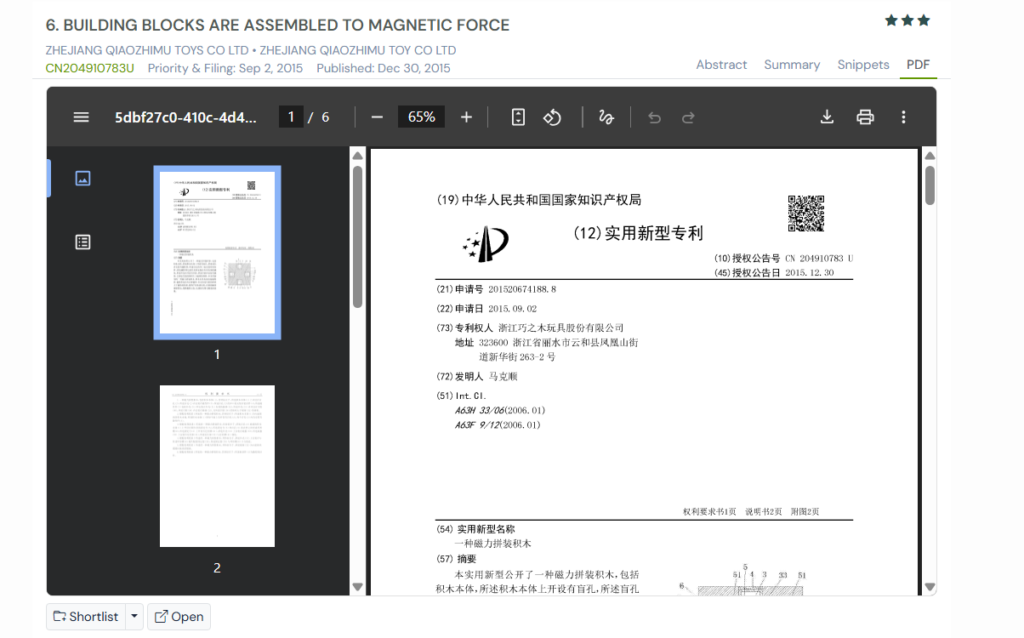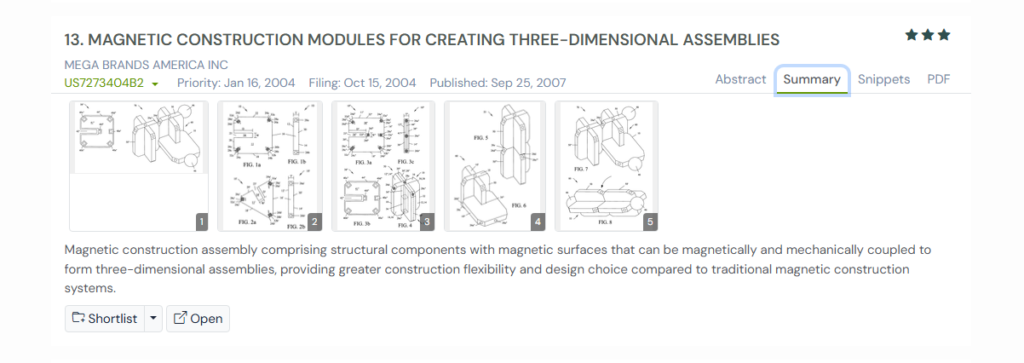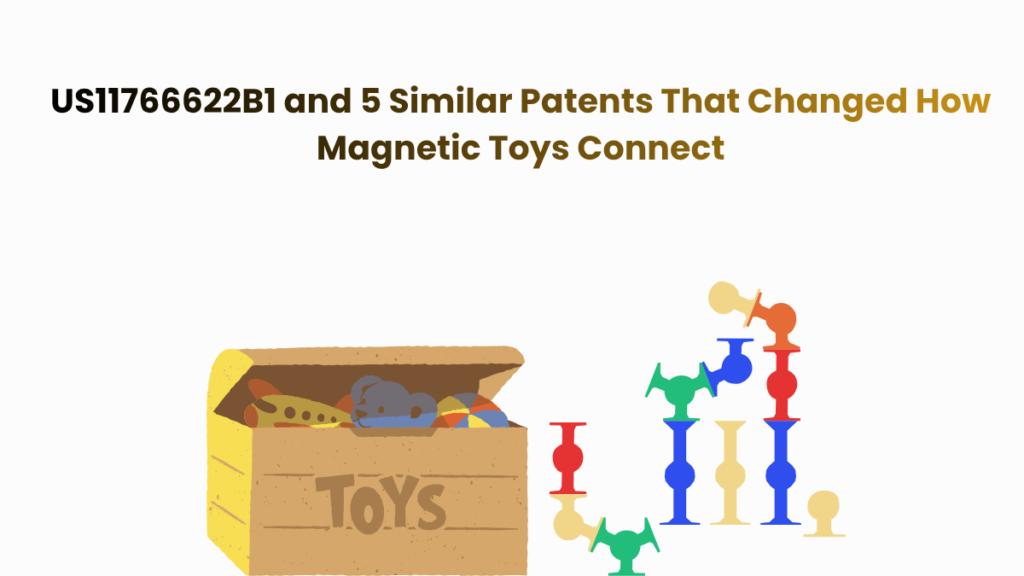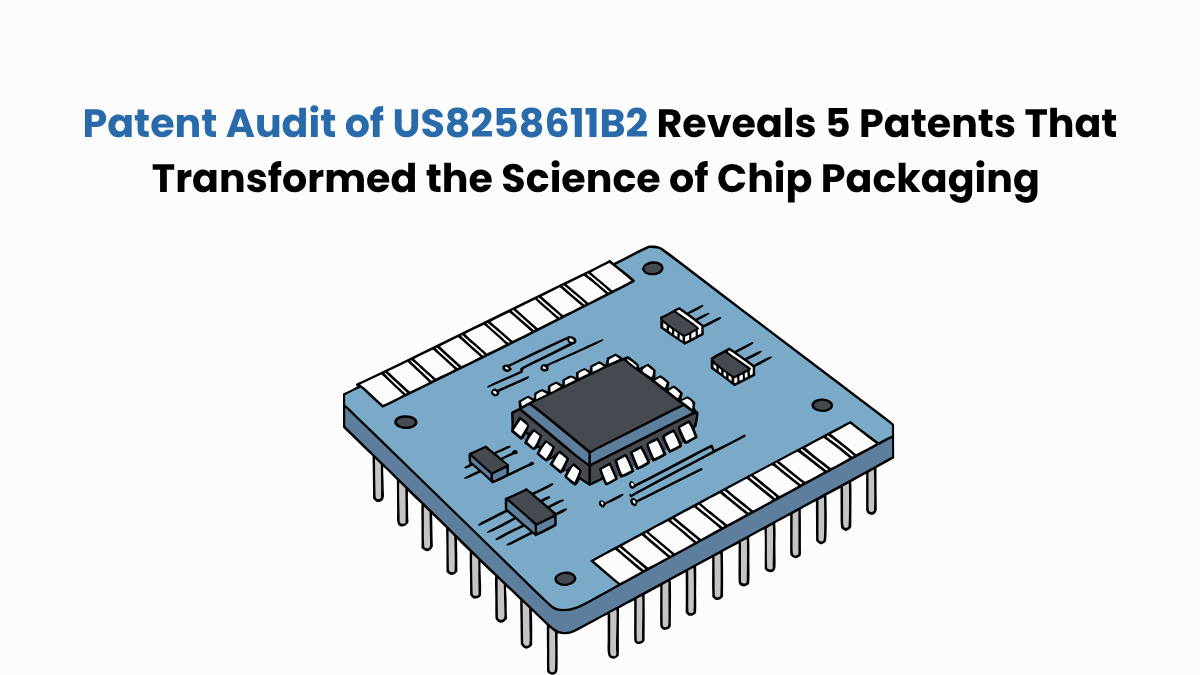Anyone who has played with magnetic blocks knows the struggle. Some sides click together perfectly. Others push away no matter how many times you try. The tower wobbles, collapses, and the fun fades.
Inventor Peixia Chen saw the problem differently. She believed the issue wasn’t in the child’s hands but inside the block itself. Her patent US11766622B1 introduced rotating magnets in each corner so the poles could align on their own.
The result was magical. Blocks connected from any direction, and towers stood firm even at odd angles.
Chen later built on this idea through US12151182B2, refining how the magnets were supported inside each block. What began as a small tweak soon became a breakthrough and subject of multiple infringement suits in magnetic toy design.
Before we go any further, let’s uncover the subject patent.
Inside US11766622B1 – The Design That Transformed Magnetic Play
At first glance, the magnetic blocks envisioned look like any other toy on a shelf. They have smooth edges and that familiar click when they come together.
The thing that sets them apart is what you don’t see. Inside every corner sits a tiny magnet that can spin freely within its compartment. So when two blocks move close, the magnets quietly rotate until their poles align, pulling the pieces together from almost any angle.
That simple motion changed everything. To make it work, US11766622B1 introduced an installation bracket, a small internal frame that keeps the magnets in place while still letting them move. Each cube holds eight of these compartments, one at every corner, giving every side the power to connect.
Later, in her continuation patent US12151182B2, inventor Peixia Chen refined the same idea, strengthening how the magnets are supported inside.
Together, the two designs turned ordinary stacking into a new kind of creative play.
The Hidden Engineering Inside US11766622B1
Every successful invention solves a small frustration in a clever way.
For US11766622B1, it was the challenge of keeping magnetic blocks connected beyond straight lines.
Here’s what makes this patent stand out.
- Rotating Magnets in Every Corner: Each corner holds a magnet that can freely spin inside its space. This helps the magnets align on their own and connect from any direction.
- Corner Compartments: Every magnet sits in its own tiny compartment inside the block. These compartments keep the magnets separate and steady while they move.
- An Installation Bracket That Holds It All Together: A small internal frame secures the magnets in place. It allows rotation without letting the magnets slip or detach.
- A Cube Built for Endless Combinations: The block is shaped with six connected sides and eight corners. Each corner works as an independent connection point, making the building process smooth and versatile.
Together, these simple features turned a basic toy into a smarter way to build, proving that small design changes can spark big imagination.
Recommended read: US6506148B2 explores another fascinating use of magnetic fields, not in play, but in how electromagnetic forces can influence biological systems at a neural level.
Earlier Patents That Paved the Way for US11766622B1
US11766622B1 didn’t appear out of nowhere. Every big invention has smaller sparks behind it: a few clever ideas had already tried to fix the same magnetic connection problem.
Using the Global Patent Search tool, we traced those early designs that quietly set the stage for this breakthrough.
Let’s explore some of them:

1. US7955156B2 – The Foundation of Free-Moving Magnetic Blocks
Magnetic toys have always been a favorite among children, but they came with one big limitation i.e. the magnets worked only when aligned perfectly.
If a block was turned slightly off-axis, the connection would fail, interrupting the fun and limiting creativity.
That’s where US7955156B2, filed by RC2 Brands Inc. in 2008, made a real difference. It introduced freely moveable magnets enclosed in small casings inside the blocks. These magnets could slide or rotate within their compartments, automatically aligning their poles whenever two blocks came near each other. The design allowed smooth attachment from almost any angle, creating more stable and flexible structures.

The concept connects directly with US11766622B1, which advanced this same idea further.
While RC2’s design placed movable magnets on block faces, US11766622B1 refined the mechanism by embedding rotatable magnets in corner compartments.
How It Shaped the Next Wave of Magnetic Toys
US7955156B2 proved that magnetic play could be more than simple stacking. It showed that when magnets are free to move, creativity naturally follows.
This idea became the base for later inventions like US11766622B1, where the same principle of free alignment evolved into a more advanced, corner-based magnetic system.
2. CN204745674U – Toy That Let Magnets Think for Themselves
CN204745674U, filed by Ming Yuping in 2015, was another patent trying to solve the same issue.
It described a magnetic splicing toy where each magnet could freely rotate inside a small casing. The magnet had two poles divided by a central plane and could spin around its axis until it found the right alignment. So even if two blocks met at odd angles, the magnets would turn on their own and lock together.
This design not only made the toys easier to use but also made them smarter in how they connected. The magnets essentially “found” their way to attraction, creating more stable and creative builds.
The concept aligns closely with US11766622B1, which refined this same idea. While the Chinese model focused on a single rotating magnet in a shell, US11766622B1 took the innovation further by placing multiple rotating magnets inside corner compartments, each supported by internal structures that made every block connection even more precise and flexible.
How It Shaped the Next Wave of Magnetic Toys
CN204745674U showed how a simple change in magnetic freedom could completely transform how toys behave.
It solved the biggest pain point of traditional magnetic blocks i.e. limited orientation, and inspired designs like US11766622B1, where free rotation evolved into structured multi-angle connectivity.
3. CN204910783U – The Block That Solved the Magnet Rejection Problem
CN204910783U, filed by Zhejiang Qiaozhimu Toys Co. Ltd. in 2015, was another Chinese patent trying to solve the attraction problem in magnetic toys.
The invention introduced a clever internal setup where each block had small blind holes with a magnetic unit placed inside. The magnet sat loosely within a shell that was slightly larger than the magnet itself, allowing it to rotate freely.
So whenever two blocks came close, the magnets would automatically spin until opposite poles aligned, creating an instant attraction instead of repulsion. This simple adjustment meant that any side of a block could now connect smoothly to another, with no fixed directions or rejected fits.

The idea connects directly with US11766622B1, which took the same principle a step further.
While CN204910783U placed its rotating magnets in flat-faced cavities, US11766622B1 refined it by embedding rotatable magnets inside corner compartments supported by structured brackets.
This shift allowed for more angles, tighter fits, and a wider range of building possibilities.
How It Shaped the Next Wave of Magnetic Toys
CN204910783U redefined how magnetic blocks connect. By letting magnets rotate freely, it removed the problem of repulsion and made connections effortless.
This simple yet smart change laid the foundation for modern designs like US11766622B1, where flexibility meets precision.
4. WO2017152483A1 – Rotary Magnetic Assembling Block
As magnetic toys grew more sophisticated, the focus started to shift from just joining pieces to engineering smoother, more flexible connections.
WO2017152483A1, filed by Leung Wai Lun Nicholas in 2016, captured that change beautifully.
It introduced a modular block with a hollow box-like body, internal posts, and cavities that held a magnet free to rotate within its space. The design allowed every face of the block to interact independently, ensuring balance, symmetry, and creative freedom.
The concept aligns closely with US11766622B1, which took this idea a step further. While WO2017152483A1 established the rotating-magnet foundation, US11766622B1 refined it through structured corner placement and better internal support, achieving stronger, more consistent attachment between blocks.
How It Shaped the Next Wave of Magnetic Toys
The patent marked a shift from trial-and-error assembly to precision engineering in magnetic toys.
It inspired systems where motion and magnetism worked together, leading to designs that were not only fun to build with but mechanically elegant too.
Recommended read: RFID innovations rely on the same electromagnetic principles that make these blocks interact, using magnetic fields to transmit identity and data across close distances.
5. US7273404B2 – Magnetic Construction Modules for Creating Three-Dimensional Assemblies
Building toys had always been fun until they became limiting. Most magnetic sets could form only a handful of shapes. The blocks were fixed, the angles were predictable, and one wrong alignment could break the design apart. Creativity had boundaries built right into the toy.
That’s where US7273404B2 by Mega Brands America Inc. changed the game. The patent introduced blocks that didn’t just stick together magnetically, they could lock together mechanically too.
Each block carried magnets in its corners and edges, working in perfect balance with slots and joints. This meant builders could create stable structures, moving parts, and new angles that earlier toys couldn’t handle.

The idea laid a clear path toward US11766622B1, which took this balance even further with improved magnet housing and stronger connection points.
How It Shaped the Next Wave of Magnetic Toys
The patent made magnetic play more than a connection, it made it construction. It gave toys the freedom to bend, hold, and move, shaping the foundation for the next generation of creative, modular designs.
Comparing the Building Blocks of Innovation
Across decades, inventors have tried to make magnetic toys smarter, smoother, and more flexible. Each patent solved a piece of the puzzle, from free-rotating magnets to hybrid mechanical joints.
To see how these ideas played a role in the evolution of our subject patent, here’s a side-by-side look at the core innovations that shaped today’s magnetic construction systems.
| Patent No. | Filed By / Year | Core Focus | Technical Overlap with US11766622B1 | The Broader Picture |
| US7955156B2 | RC2 Brands Inc., 2008 | Introduced freely movable magnets inside casings that automatically aligned when blocks came close. | Established the idea of dynamic magnetic alignment that US11766622B1 later perfected through corner-based rotating systems. | Proved that giving magnets mobility could unlock endless creative combinations in magnetic toys. |
| CN204745674U | Ming Yuping, 2015 | Added self-rotating magnets inside cylindrical shells to let blocks attract from any direction. | Shared the same rotational mechanism that US11766622B1 enhanced with multiple magnet housings and improved angular stability. | Turned basic polarity correction into an intelligent self-aligning feature, making play smoother and smarter. |
| CN204910783U | Zhejiang Qiaozhimu Toys Co. Ltd., 2015 | Designed blind-hole magnetic housings with magnets free to rotate inside slightly oversized shells. | Inspired the internal structure used in US11766622B1, which optimized magnet fit and rotation control through precise corner casings. | Solved the problem of magnet repulsion and laid the foundation for multi-directional magnetic assembly. |
| WO2017152483A1 | Leung Wai Lun Nicholas, 2016 | Introduced modular blocks with hollow interiors and rotatable magnets embedded on each face. | Directly aligned with US11766622B1’s rotating mechanism, later refined through corner placement and stronger internal support. | Shifted focus from random assembly to precision engineering, blending motion and magnetism into one fluid system. |
| US7273404B2 | Mega Brands America Inc., 2004 | Combined magnetic and mechanical joints for constructing complex 3D models. | Reflected in US11766622B1’s hybrid approach that emphasized both magnetic strength and structural balance. | Transformed magnetic play into a form of real construction, paving the way for versatile, modular toy design. |
Did you know? The same principles that let magnetic blocks snap together also make wireless charging possible. Explore how Tesla’s early magnetic resonance experiments evolved into the charging systems we use today.
Tracing the Evolution of Magnetic Innovation with GPS
Each of these patents reveals a step forward in how magnetic toys evolved, but the real insight comes when you connect them together.
That is where the Global Patent Search tool changes the game. It helps trace how one invention sparks the next, uncovering links between movable magnets, corner-based systems, and hybrid connection models that shaped the magnetic toys we see today.

Here’s how GPS helps you explore those connections:
- Start from any patent: Type in a number like US11766622B1 or describe the invention, and GPS will instantly surface related patents on magnetic assemblies, block structures, or rotational mechanisms.
- See the chain of ideas: GPS displays short, meaningful snippets showing how inventors improved earlier systems to solve new challenges in connectivity and design.
- Dive deeper into evolution: With one click, you can explore complete documents to understand how concepts like free-moving magnets evolved into precise, corner-based configurations.
- Spot cross-domain influence: GPS reveals how design principles from toys, mechanics, and engineering overlap, showing how one field quietly inspires another.
By connecting these dots, the GPS tool turns scattered patent data into a timeline of innovation. This helps creators, researchers, and engineers understand how ideas grow, adapt, and shape the next wave of invention.
If you want to see how one simple concept can transform into an entire generation of smarter magnetic systems, the Global Patent Search tool is your best place to begin.
Disclaimer: The information provided in this article is for informational purposes only and should not be considered legal advice. The related patent references mentioned are preliminary results from the Global Patent Search tool and do not guarantee legal significance. For a comprehensive related patent analysis, we recommend conducting a detailed search using GPS or consulting a patent attorney.
Frequently Asked Questions
1. Why do some magnetic blocks repel each other?
This happens when the magnet’s poles face the same direction. Modern designs solve this by using rotating magnets that automatically flip to the right orientation, ensuring they always attract instead of repel.
2. What makes new-generation magnetic toys different from older ones?
Earlier blocks worked only when perfectly aligned. The new ones feature rotating or floating magnets that self-adjust, allowing smoother connections from any angle and more creative freedom.
3. Are magnetic building toys safe for children?
Yes, when made according to safety standards. The magnets are usually enclosed in thick plastic shells or compartments so they cannot be removed or swallowed.
4. What materials are used in making magnetic building blocks?
Most sets use ABS plastic for durability and rare-earth magnets like neodymium for strong magnetic force. Some designs also include soft edges and reinforced corners for safety.




